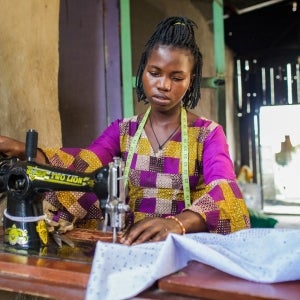Between the late teen and early adulthood years, many young women in low-income countries undergo critical transitions – leaving school, entering the workforce, marriage, motherhood – that shape not only the rest of their lives but often those of future generations as well. Research has shown that appropriate financial inclusion initiatives can help them successfully navigate these transitions. But what exactly does “appropriate” mean here?
Multiple lives by 25
By the time they reach 25, many women in low-income settings have already lived multiple lives. Take Tessa*, for example. As a young teen in Morogoro, Tanzania, Tessa dreamed of studying to become a nurse. Unfortunately, her mother’s death led to her leaving school after grade seven. She began working at a hotel but had to leave that job when she became pregnant at 19. A few years after that, her partner left her, obligating Tessa to start her own business to support herself and her child.
Luckily, Tessa’s mother had passed down her entrepreneurial skills, and at 24, Tessa is now running a small restaurant. She would like to access financing to expand her business but finds conventional loan terms too rigid, so she is participating in an informal savings and loan group that provides her with more repayment flexibility. Eventually, she would also like to save up and perhaps get a loan to buy a plot of land and build a home. Unfortunately, however, the group cannot provide those types of long-term financial mechanisms.
Not yet 25, Tessa is already a striving entrepreneur with the welfare of the next generation on her shoulders. Helping young women like her reach their goals is not just intrinsically important, it’s pivotal for development – and financial services are an essential component of that support. So, how can financial services better serve young women?
Financial services tailored to young women
Financial service providers (FSPs) and nongovernmental organizations (NGOs) have been iterating on this question for almost two decades, resulting in a deep – but dispersed – base of industry-wide knowledge. To consolidate this learning and leverage it for future innovation, CGAP recently conducted an extensive review of lessons learned and, with the help of over 30 expert practitioners and 40 peer reviewers, distilled them into a new paper entitled “Young Women and Financial Inclusion: What Works.”
The first key to better serving young women is knowing which young women you’re talking about. As Tessa’s story shows, between the ages of 15 and 24 young women can vary dramatically along several key life stage dimensions, including age, occupational status, and family position. The pace at which a given young woman moves along any of these dimensions is greatly influenced by social norms, socioeconomic status, and rural/urban location.
The first key to better serving young women is knowing which young women you’re talking about.
Generally, however, the beginning and end points of these transitions cluster together and can be thought of in two broad categories of segments. “Dependents” are generally under the age of majority, under the care of others, and spend most of their time on studies, while “independents” are generally legal majors, can be in a caregiver role, and spend most of their time on paid or unpaid work. These life stage dimensions are important to understand because they shape a young woman’s financial characteristics – i.e., access to and control over money, dependence on others, complexity of financial needs, and access to financial services infrastructure – that, in turn, determine the right financial inclusion strategy for her.

Five key components of financial inclusion strategies for young women
In crafting their strategy, organizations providing or facilitating financial services for young women should pay particular attention to five key components.
Product design
This can mean tailoring features to fit their life stages, with retention enhanced by offering products that evolve alongside their changing needs. The gateway product in that series should be savings, which play a foundational role for all segments of young women, though their level of access to financial services is a critical determinant of whether formal or informal solutions are more appropriate. As clients approach the “independent” end of the spectrum, they will develop greater ability and reason to take up a full suite of formal products – including payments, insurance, and, importantly, loans – which can then be layered on.
Product delivery
For “dependent” segments, group delivery mechanisms can fulfill some of these requirements and offer the added advantage of simultaneously building social and financial assets. For segments with internet connectivity, digital methods can also provide conducive delivery channels. But digital cannot entirely replace the human element in sales and service, which is still important when serving young women, especially since many may be unfamiliar with formal financial services. Investment in training and incentives for quality service can be pivotal to developing young women into profitable, long-term clients.
Financial capability building
Focusing financial capability content on the “critical minimum” – concepts (including digital financial literacy) that are absolutely essential to the safe and effective use of financial services – optimizes time and resources for both providers and participants. Various models can optimize delivery, including using FSP staff as trainers, training youth ambassadors, having agents advise clients, and partnering with NGOs. In any model, reinforcing content via additional channels and presenting it in short, easily digestible pieces can enhance effectiveness.
Social intermediation
Social intermediation refers to activities that tackle nonfinancial capability or relational gaps that may prevent young women from making effective use of financial services. Providing livelihood support in conjunction with financial services can be especially powerful, as one enables the other. Engaging gatekeepers who control access (e.g., parents, in-laws) is another often important aspect of social intermediation. The more severe the economic empowerment constraints for a given segment of young women, the more valuable these types of social intermediation become.
Commercial viability
Different segments of young women require different lead times to become profitable FSP customers, with “dependent” segments generally requiring more time than “independent” segments. In addition, financial capability building and social intermediation often require very different skill sets than those FSPs normally possess. Therefore, many financial institutions that aim to cultivate young women as long-term clients choose to partner with specialized NGOs with both the competencies and cost structures to undertake such activities. To be successful, the working modalities of such partnerships must be made explicit, with management on both sides ensuring the agreement is understood and internalized at every level of their organization.
By integrating the principles above, financial service providers and facilitators can help close the financial inclusion gender gap where it begins – in early adulthood. Doing so will not only help them access an untapped group of potential long-term clients but also, and equally importantly, help young women like Tessa access critical tools to achieve their dreams.
*Name changed for privacy



